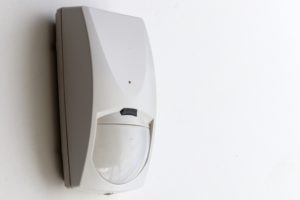Motion Sensor Alarm Systems
 Using acoustic, microwave or optical technologies, motion sensors can be used for the detection of movement in commercial and industrial settings. Also known as motion detectors, they can significantly strengthen the security of buildings and outdoor premises by detecting unauthorized movements of individuals.
Using acoustic, microwave or optical technologies, motion sensors can be used for the detection of movement in commercial and industrial settings. Also known as motion detectors, they can significantly strengthen the security of buildings and outdoor premises by detecting unauthorized movements of individuals.
Although motion sensors have various types, they generally belong in two categories: active and passive.
- An active sensor utilizes radar for the emission of radio waves, which generate reflections off walls and objects across an area within its range. If movement causes the interruption of a wave, the detector will set off an alarm.
- A passive sensor monitors infrared heat levels in order to determine whether or not changes in ambient temperature have occurred in the area within its range. If a passive sensor detects a temperature change caused by the infrared signature of a person entering its scanning area, it will sound an alarm.
Typical Business Uses of Motion Sensors
There are several uses of motion sensors on commercial properties that will help improve security and safety as summarized by the following:
Area Security
In large facilities, it is often a challenge to monitor restricted areas around the clock. However, motion detectors can be utilized in several ways for restricting particular parts of premises at certain times. For example, a specific area may be restricted from any sort of entry after hours. Any entry during a set period of time will sound an alarm.
Crime Prevention
After hours acts of vandalism or crime outside premises can be discouraged or stopped by motion sensors that immediately turn on security lighting or trigger very loud alarms. When an intruder enters premises silently, people nearby may not notice. Fortunately, even stealthy thieves, including those who are stowaways, will be unable to evade sensors designed to detect movement or infrared radiation generated by bodies. When a burglar passes a beam, an alarm will sound, summoning either security staff or police within minutes.
Lighting Activation
Lighting can be linked to motion sensors to automatically turn on when an individual enters a room or a hallway. This not only helps conserve energy, it will promote security and safety in areas that would otherwise be quite dark.
Monitor Entry of Personnel
Motion sensors can be utilized to open doors after accepting the entry of a proper code or the use of a key card by authorized personnel. This not only improves the security of premises, it can make the entry of employees more convenient by eliminating keys, which can be lost or stolen and result in having to replace locks. In addition, the gates of parking lots can be automatically activated when a sensor detects the valid pass of an employee.
Motion Sensor Alarm System
Linked by low-voltage Ethernet cabling, a motion sensor alarm system is typically made up of the chief components below:
- Motion Detector – Usually a passive infrared sensor that is housed in a white block featuring a semi-translucent panel receiving infrared radiation that can detect changes in temperature caused by a person’s entry.
- Electronic Control Panel – Typically an integrated panel for controlling several sensors, interpreting their signals, and transmitting the gathered information.
- Desktop or Mobile Application – Modern systems are usually capable of being managed from either a desktop or mobile application. The most advanced products are based in the cloud and integrated with an online platform for the management of security personnel.

